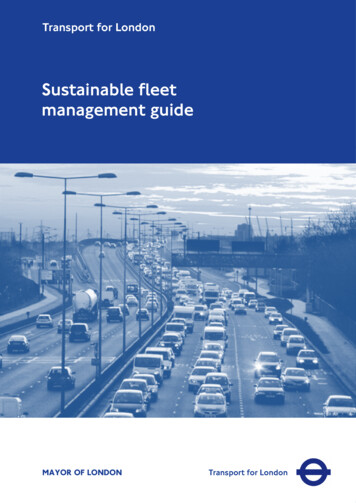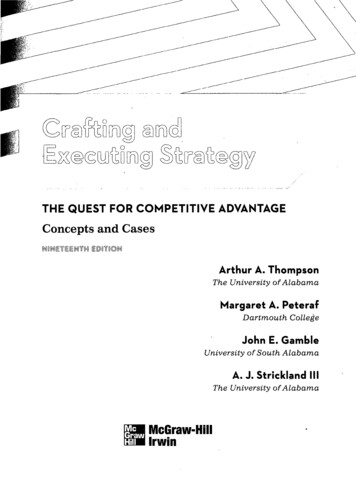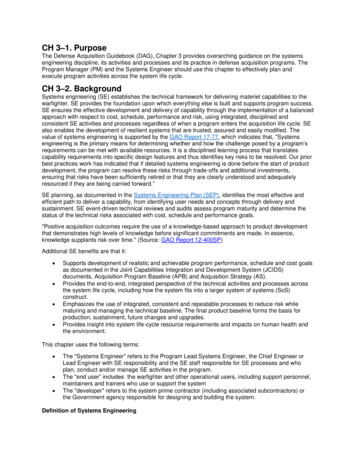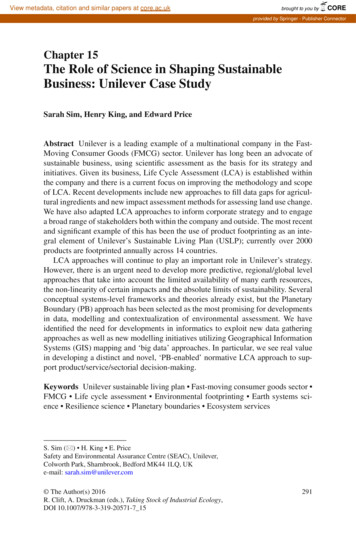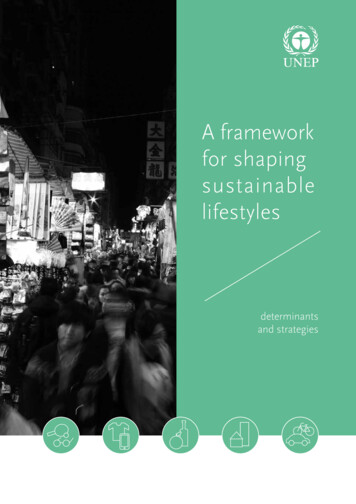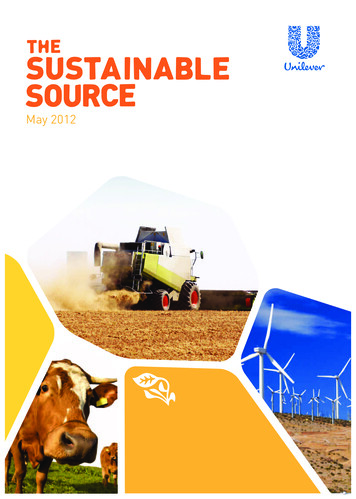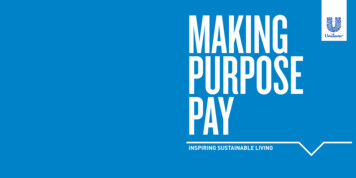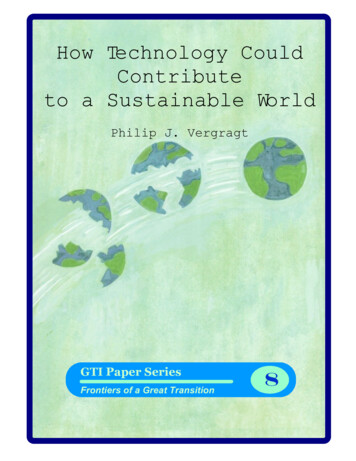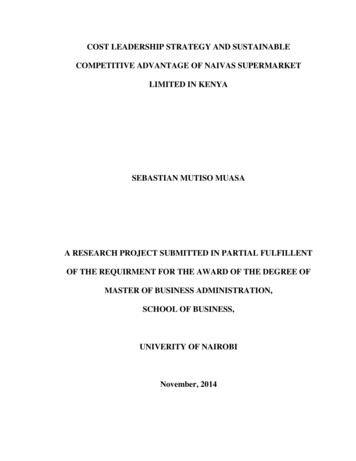
Transcription
COST LEADERSHIP STRATEGY AND SUSTAINABLECOMPETITIVE ADVANTAGE OF NAIVAS SUPERMARKETLIMITED IN KENYASEBASTIAN MUTISO MUASAA RESEARCH PROJECT SUBMITTED IN PARTIAL FULFILLENTOF THE REQUIRMENT FOR THE AWARD OF THE DEGREE OFMASTER OF BUSINESS ADMINISTRATION,SCHOOL OF BUSINESS,UNIVERITY OF NAIROBINovember, 2014
DECLARATIONI declare that this is my original work and has not been presented for a degree in anyother university or college for examination or academic purposes.Signed Date .Sebastian Mutiso MuasaD61/63307/2011This project has been submitted for examination with my approval as the universitysupervisor.Signed . Date . .Dr. Zack B Awino, PHDSenior Lecturer,Department of Business Administration,School of Business,University of Nairobi.ii
ACKNOWLEDGEMENTSI would like to take this opportunity to thank the Almighty God for His guidance, careand providence which enabled me to undertake this project. My sincere thanks also go tothe management of Naivas Supermarket Limited, for their cooperation and in providingthe data that was quite useful in doing this research. I am also glad to note that theUniversity of Nairobi granted me an admission into the School of Business to undertakethis worthy course.I am indebted to my supervisor Dr. Zachary Awino for the role he played in guiding theentire research period. He was a source of encouragement and his thoughts contributedgreatly to my success. Lastly I would like to acknowledge my family for the great moralsupport they provided while I was working on this project.iii
DEDICATIONThis research project is dedicated to my wife Caroline Wanjiru and my two sons JosephMuasa and Ethan Mbatia who have sacrificed to see me through my MBA Studies, myparents the late Joseph Muli and Grace Muli as well as my siblings who have been thereto inspire, challenge and support me during the course of my studies.iv
TABLE OF CONTENTSDECLARATION . iiACKNOWLEDGEMENTS . iiiDEDICATION . ivLIST OF TABLES . viiLIST OF FIGURES . viiiABBREVIATIONS AND ACRONYMS . ixABSTRACT .xCHAPTER ONE: INTRODUCTION .11.1 Background of the Study .11.1.1 Cost Leadership Strategy . 21.1.2 Sustainable Competitive Advantage .31.1.3 Retail Chain Industry in Kenya .61.1.4 Naivas Supermarket Limited .81.2 Research Problem .121.3 Research Objective .141.4 Value of Study .14CHAPTER TWO: LITERATURE REVIEW.162.1 Introduction.162.2 Theoretical Foundation .162.3 Cost Leadership Strategy and Sustainable Competitive Advantage Relationship .182.4 Challenges of cost leadership strategy implementation .22CHAPTER THREE: RESEARCH METHODOLOGY .253.1 Introduction.253.2 Research Design .253.3 Data Collection .263.4 Data Analysis .27v
CHAPTER FOUR: DATA, FINDINGS AND DISCUSSIONS .284.1 Introduction.284.2 Demographic and personal information .284.3 Adoption and application of cost leadership strategy .294.3.1 Understanding cost leadership strategy .304.3.2 Impact of Organization structure on cost leadership strategy .334.3.3 Creating a sustainable competitive advantage .374.4 Successful managing of cost leadership strategy at Naivas .434.4.1 Key success factors of cost leadership strategy implementation .434.4.2 Strategy communication .484.4.3 Challenges of managing the business environment .504.5 Discussion and findings .56CHAPTER FIVE: SUMMARY, CONCLUSION AND RECOMMENDATION .605.1 Introduction.605.2 Summary of the findings .605.3 Conclusion .615.4 Recommendations.625.5 Limitations of the study .645.6 Area for further study .655.7 Implications of the Study on Theory, Policy and Practice .66REFERENCES .68APPENDICES .72Appendix I: Introduction Letter .72Appendix II: Interview Guide .73Appendix III: Authorization Letter .76vi
LIST OF TABLESTable 1.1: Naivas Supermarket branch outlets .9Table 4.1: Price analysis of sampled shopping basket on basic items .41vii
LIST OF FIGURESFigure 1.1: Naivas strategy in cost leadership .6Figure 2.1: Dynamic capabilities life-cycle .17Figure 2.2: A model of competitive advantage .22Figure 4.1: Naivas Organizational structure .35Figure 4.2: Naivas Strategy Execution Process .37Figure 4.3: Price analysis of sampled shopping basket on basic items. .42viii
ABBREVIATIONS AND ACRONYMSBODBoard of DirectorsCAKCompetition Authority of KenyaCEOChief Executive OfficerERPEnterprise Resource PlanningHELBHigher Education Loans BoardHRMHuman Resources ManagerICTInformation Communication TechnologyKSFsKey Success FactorsKYCKnow Your CustomerGMDGroup Managing DirectorODOperations & DistributionsPOSPoint of SaleROIReturn on InvestmentSMTSenior Management TeamVATValue Added Taxix
ABSTRACTThe retail chain industry is undergoing a fundamental structural shift. For many, survivalof the retail chain business depends on their ability to develop new business models toenable them adapt to the ever changing environment. The purpose of strategy accordingto Ramaswamy and Namakumari (1996) is to exploit the unique advantages of theorganization in facing the challenges of the environment. The successful corporationsmake their strategic priority to build their core competencies and long term competitiveadvantages. To acquire competitive advantage in any market, a firm needs to be able todeliver a given set of customer benefits at lower costs than competitors, or providecustomers with a bundle of benefits its rivals cannot match. To realize the potential thatcore competencies create, a company must also have the imagination to envision marketsthat do not yet exist and the ability to stake them out ahead of competition (Hamel andPrahalad 1991; Porter 1980). Businesses become successful when they posses someadvantage relative to their competitors (Pearce and Robinson, 1997). This paper seeks toexamine the effects of cost leadership strategy and sustainable competitive advantage ofNaivas supermarket in Kenya. The increasing global nature of competition requires thatthe firm utilizes all of its valuable resources in order to survive and succeed. Therefore,Naivas as a retail chain needs to identify and build on the cost drivers and key successfactors that are sustainable and will set it above other supermarkets in the industry ascompetition intensifies. The study was carried out through a case study design of NaivasSupermarket where primary data was collected using an interview guide and secondarydata obtained from the company website, Industry periodicals and company publications.Personal interviews were done with Naivas Supermarket Human Resource Manager,Operations Manager, Purchasing & Supplies Manager, ICT Manager, BusinessDevelopment & Marketing Manager and Finance Manager at the company‟s head officein Nairobi‟s Sameer Industrial park using an interview guide. Content analysis techniquewas used to analyze the data. The study found that Naivas supermarket had to a largeextend applied the cost leadership strategy on its operations by defining its low andmiddle income market niche, but more needs to be done to enhance the efficiency of thecost leadership business model. The study further established that the retail chainbusiness environment is moderately changing and is characterized by dominant privatelyowned firms which inform the kind of competitive strategies adopted. It was found thatfor cost leadership strategy to be effective, high investment in technology, customerfocus, selling a wide range of products, improving employee morale, effectivemanagement and good relations with suppliers were all key success factors in actualizingthe strategy to ensure a sustainable competitive advantage. The study also established ascritical for senior managers to undergo occasional training and scenario exposures to beup to speed with dynamic industry environmental factors. The study recommendedfurther research could be carried out on cost leadership and differentiation strategies inthe retail chain business owing parallel strategies often adopted. Additionally there isneed to explore on the challenges of applying cost leadership in a controlled marketeconomy.x
CHAPTER ONEINTRODUCTION1.1 Background of the StudyCost Leadership is one of Porter‟s five generic strategies that a business could implementin order to secure a sustainable competitive advantage over its competitors within theindustry, thereby earning a higher profit. The five strategies are comprised of three basicclassifications: cost leadership, differentiation, and focus, which target either a broad or anarrow market segment (Porter, 1980). According to Porter, a business should focus itsresources toward pursuing one of the strategies, as opposed to trying to implement two ormore of the generic strategies. If a business pursues more than one strategy, it willbecome “stuck in the middle” (Porter, 1980). Owing to the inherent contradictions inthese strategies, a firm could overextend its resources and fail to instill a seamlessbusiness philosophy consistent with one of the generic strategies.Cost leadership dictates that costs are kept to a minimum, while differentiation dependson the development of unique features and attributes, which often requires increaseddevelopment and production costs. When a business becomes stuck in the middle, it is atrisk of losing its competitive advantage, and becoming unable to differentiate its productor service from a competitor, often resulting in poor financial performance (Porter, 1980).1
This study is anchored on the theory of dynamic capability on sustainable competitiveadvantage. A dynamic capability is a learned and stable pattern of collective activitythrough which the organization systematically generates and modifies its operatingroutines in pursuit of improved effectiveness (Teece, 2007). The basic assumption of thedynamic capabilities framework is that core competencies should be used to modifyshort-term competitive positions that can be used to build longer-term competitiveadvantage. The academic literature on dynamic capabilities grew out of (1) the resourcebased view of the firm and (2) the concept of "routines" in evolutionary theories oforganization (Teece, 2007).The study focuses on cost leadership strategy and sustainable competitive advantage ofNaivas Supermarket Chain in Kenya. Cost leadership is a concept developed by MichaelPorter, used in business strategy which describes a way to establish a competitiveadvantage. Cost leadership, in basic words, means the lowest cost of operation in theindustry that is often driven by company efficiency, size, scale, scope and cumulativeexperience (learning curve). A cost leadership strategy therefore aims to exploit scale ofproduction, well defined scope and other economies thus producing highly standardizedproducts, using high technology (Porter, 1998).1.1.1 Cost Leadership StrategyThe purpose of strategy according to Ramaswamy and Namakumari (1996) is to exploitthe unique advantages of the organization in facing the challenges of the environment. Astrategy begins with a concern and a burden of how best to use the limited resources of2
the organization. The successful corporations make their strategic priority to build theircore competencies and long term competitive advantages, so that they will serve the realback up for the business level strategies of the business units in the corporation. Toacquire competitive advantage in any market, a firm needs to be able to deliver a givenset of customer benefits at lower costs than competitors, or provide customers with abundle of benefits its rivals cannot match.Cost leadership enables you to establish a competitive advantage in the market. This canhelp to increase sales and overall turnover and help in any expansion plans. Any costleadership strategy has to be one in which you are able to achieve the lowest cost ofoperation per unit of production, compared to others in the same industry. An overall costleadership strategy concentrates attention on a company‟s value chain resulting in lowcost products and services. Little attempt is made to differentiate products or servicesfrom those of competitors, and a wide net is cast over the entire potential market. Byoffering the lowest possible cost, these companies gain market share through price alone.The most successful companies are those that limit down costs at each point in the valuechain (Porter, 1980).1.1.2 Sustainable Competitive AdvantageBusinesses succeed when they posses some relative advantage to their competitors.Gaining this competitive advantage is the objective of the strategy (Porter, 1998).Corporations which gain competitive advantage in their industries usually adopt specificstrategies including innovation, improved processes, higher quality, lower cost and3
marketing in order to achieve this goal.When a firm has achieved a competitiveadvantage and successfully raises the barriers preventing imitation by competitors itthereby “resists erosion by competitor behavior” and achieves sustainable competitiveadvantage (Porter, 1998). Preventing imitation however does not last forever. Thus afirm‟s ability to delay this eventuality is essential in order to derive the maximum benefitfrom any competitive advantage.A company is therefore said to have a competitive advantage if it is the acknowledgedleader in product quality, has a different value chain than rivals and has some type ofedge over rivals in attracting customers and coping with competitive forces. Whereasthere are many routes to competitive advantage, they all involve; building a brand nameimage that buyers trust, delivering superior value to buyers and building competences andresource strengths in performing value chain activities that rivals cannot readily matchand lastly achieving lower costs than rivals and becoming the industry sales and marketshare leader. The biggest and most important differences among the competitivestrategies of different companies boil down to how they go about building a brand nameimage that buyers trust and whether they have a high risk appetite or are risk averse andsecondly the different ways that companies try to cope with the five competitive forces.(Porter, 1998)When you walk into Naivas, the first thing you will notice is that the prices of theNaivas are much lower than those of any other stores. Why does Naivas offer lowerprices? What are its strategies in lowering the prices? The main strategies are efficiency4
in supply chain management, efficiency in operations and distribution and bargainingpower. Naivas is incredibly successful in managing its supply chain, an achievementmade possible through applying the most reliable supply chain management systemwhich is very efficient because almost all product data can be tracked to and from themanufacturer, warehouse, and the store shelf. Efficiency in supply chain system hassaved Naivas several million shillings as it does prevent losses from faulty productmanagement.Secondly, Naivas has optimized efficiency in operations and distribution strategies.These OD strategies have helped Naivas achieve low prices by managing its distributionfunctions from its warehouse at the Sameer Industrial Park Head Office, from wheredistribution is further done to smaller stores outside of large cities. By bunching storestogether in small areas, distribution costs are below average.Thirdly, through bargaining power, Naivas buys its products at rock-bottom prices,exchanges high purchase volumes for low cost while passing the savings onto itscustomers. The bargaining power of suppliers is weak therefore many suppliers even givein to Naivas‟s pressure because they depend on the discount retailer for a large volume oftheir sales. Obviously, suppliers would do what Naivas wanted them to do if they hopedto maintain their sales. Furthermore, the bargaining power of buyers is also weak becausethere is a very broad base of customers and a significant demand for low prices.5
Source: Naivas Digest (Aug – Oct 2013)Figure 1.1: Naivas strategy in cost leadership1.1.3 Retail Chain Industry in KenyaRetail industry forms part of the fragmented industry. Kotler (1993) defines retailing ascomprising all activities involved in selling goods and services directly to the finalconsumer for personal and non-business use. Supermarkets are part of the retailingindustry. In Kenya, the supermarket segment comprises of hundreds of small to hypermarkets located across the country but with a bias in major towns and establishedupcoming middle class estates. A supermarket refers to a large, low-cost, low margin,high volume, self service store that offers a wide variety of food, laundry and otherhousehold products (Kotler, 1993). The retail chain industry consists of hundreds ofupcoming and established retail chain stores in the urban and peri-urban centers.However, industry is dominated by a few large family owned or corporate retail chainstores such as Nakumatt, Tuskys, Naivas, Uchumi, and Ukwala. These dominant players6
target cities and other large towns and the ever growing middle class as their marketniche. They trade as corporate chain stores each having two or more company controlledoutlets, stocking and selling similar line of products in different locations in the sametowns or across the country.Over the last two decades, the retail chain stores in Kenya have witnessed phenomenalgrowth, however as the industry grows, entry of new players has brought with it stiffcompetition. Besides, retail customers have become sophisticated in terms of tastes,preferences and choices, informed by forces of globalization, urbanization and improvedincomes especially among the emerging middle class. This has altered the nature ofmarket demand which has led to the supermarkets to respond by upgrading theiroperations to meet the growing demands of the market. To stem competition, attract andretain formidable loyal customer base, some have invested heavily in branding,advertising and modernized their stores as well as broadened and deepened product lines,offering elegance and comfort into the one-stop shopping concept, in ways notexperienced there before in Kenya. The retail industry in Kenya is a key sector of theeconomy and huge contributor to the national economy through employment creation,offering markets for local industries and farmers, and revenue to the Government.7
1.1.4 Naivas Supermarket LimitedNaivas Limited was registered as a private limited company on 24th July 1998. Beforethen, it traded under Rongai Self Service Stores Limited serving mainly Rongai inNakuru district. It later opened a branch in Elburgon before spreading its wings toNaivasha town. Since 1998, it was trading as Naivasha Self Service Stores Limitedbefore re-branding to the current Naivas Limited in 2007. Naivas Limited is anindigenous company run by Kenyans for Kenya as a family business. Its directors are Mr.Simon Gashwe Mukuha and Mr. David Kimani Mukuha. (Ngige, 2014)The company started as a small service store with the initial capital being contributed bythe family members. It has grown from this, to a chain of stores with branches in Eldoret,Embu, Kapsabet, Kitui, Kisii, Machakos, Mombasa, Nairobi, Naivasha, Narok, Thika tothe current 29 branches located countrywide as at January 2014. The company‟s Headoffice is situated in Nairobi‟s Industrial area, Sameer Business Park where its CentralWarehouses are also housed. (Ngige, 2014)8
Table 1.1: Naivas Supermarket branch outletsCity/ TownBranch NameStreet LocationNairobiEastgate – DonholmOutering roundaboutGreen HouseNgong RoadHazinaSouth B Shopping ComplexHomegroundNgong roadKasaraniMwiki roadKitengelaNairobi-Namanga roadKomarockKayole Spine roadMountain MallThika roadNew Ronald NgalaRonald NgalaNgong TownNgong roadRonald NgaraRonald NgalaRuarakaBaba Ndogo roadThe Mall – WestlandsWaiyaki wayUtawalaEastern BypassNakuruSuper centerOld Nairobi roadNaivashaKubwa branchBiashara streetNdogo branchKariuki Chotara roadMwatu wa NgomaNgei roadSuper centerNext to family bankReferalNandi StreetSokoniJoel Malel RoadKisiiKisiiHospital roadEmbuKumbukumbuKumbukumbu roadKituiKilungyaKilungya roadNarokOlegilishoOlegilisho roadThikaFlame Tree MallGarissa roadMachakosEldoretSource: Naivas website (http://www.naivas.co.ke) 20149
Plans for additional branches in Nairobi and Garissa are still underway which will beopened before the end of 2014. The company has intense expansion plans that will bestrategically implemented over the next few years. Over the years, Naivas Limited hasvalued its customers and that‟s why there is great emphasis on the customer service,pricing and quality of goods and service offered by the retail chain. According to themanagement, they believe in offering the best to their customers at all times. With thegrowth in the retail industry, Naivas Limited is now the fastest growing supply chainfollowing the top two in the market very closely. Although the economy has beenchallenging, Naivas continues to offer the best to its target customers who fall in the lowand medium earning groups and therefore giving value to its customers even in thestressful times of inflation.Today, customers have become more sophisticated and are aware of their choices better.With this in mind, Naivas strives to offer quality services through updating its systemswith the most efficient networking amongst all its branches and head office operations.The company has also developed a solid relationship with its suppliers who havepartnered with them to offer its customers the best prices. The chain‟s partnerships enableit to pass the price advantage acquired from suppliers to its customers through fair pricingthus negotiating on behalf of its customers because they understand their needs. It doesensure the provision of genuine goods and quality services that customers appreciate andtherefore have zero tolerance to counterfeits and endeavor to source for original itemsfrom genuine sources.10
The company‟s staffs undergo in-house training on customer service and complainthandling and also encourage feedback from its customers to continue improving thequality of services provided. The company success is attributed to its dedicated directors,staffs and esteemed customers, with its suppliers and financial partners also playing a bigrole in growing Naivas Limited from one branch to 29 branches currently.Some of its partnerships include Chase Bank which powers the loyalty programme andSafaricom which offers M-pesa Pay Goods and services. These partnerships have enabledNaivas to offer its customers ease in secure payment options as well convenience in cardtransactions. Other services offered at Naivas Limited include after sales service whichenables customers to receive service at no extra cost through delivery of goods to thecustomers‟ door step within reasonable parameters. Bulky goods like refrigerators,furniture and other household appliances are delivered to the customer‟s house from anyof the Naivas branches. For longer distances, a small fee may be charged.Naivas has invested in a loyalty program where shoppers are issued with a loyalty card(Naivas Reward card) and earn points on subsequent shopping. These points are laterredeemed at any of its branches countrywide and customers shop free of charge for thevalue of the points accumulated / earned. Currently, Naivas has issued over three hundredthousand cards and this is growing every month. In the long run, the chain plans to usethe information to study customers‟ shopping trends by use of data mining andeffectively capitalize on emerging tastes and preferences and adapt accordingly. (Ngige,2014)11
1.2 Research ProblemCost-leadership strategy seeks to offer the lowest priced offering in a product or servicecategory to customers by continually lowering costs across the board. Striking a balancebetween price and quality is essential for cost leaders, as there comes a point wheredecreases in quality are no longer justified by lower prices in consumers' minds. A costleadership strategy is a broad approach to business whereby a significant aspect of acompany's strategy is an effort to operate as the lowest-cost business in its industry.(Ingram & Kokemuller, 2009).One of the most important strategies that an organization should take into account is thatit has to be a market leader and especially in the retail sector when there is a hugecompetition from the different large players, you have to be a cost leader so as to drivethe competition away. Naivas supermarket chain has used this cost leadership strategyand integrated cost leadership with the Porter‟s five forces and has created some sort of aprice barrier for the new entries. The new entries would think twice that they have tocompete with Naivas when they would like to enter the retail market. Naivas has madecost leadership their philosophy. The slogan “Naivas Saves you Money” has given thecompany a unique selling point as the consumers are always attracted to buy items from aplace where they can get a good value for money proposition.12
Various studies have been carried out internationally on different aspects of retail chains;Goldman (2000) Researched on „Supermarkets in China: the case of Shanghai‟,Merrilees and Miller (2001) researched on „Innovation and Strategy in the AustralianSupermarket Industry‟. Flannery (2006) carried out a research case study on „Walmartcost leadership strategy‟, Omar and Sawmong (2007) furthe
narrow market segment (Porter, 1980). According to Porter, a business should focus its resources toward pursuing one of the strategies, as opposed to trying to implement two or more of the generic strategies. If a business pursues more than one strategy, it will become "stuck in the middle" (Porter, 1980).


